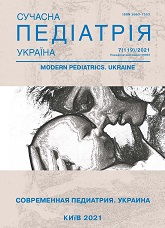Prolonged QT interval syndrome in pediatric practice: literature data and clinical case description
DOI:
https://doi.org/10.15574/SP.2021.119.55Keywords:
syndrome, QT interval, etiology, pathogenesis, clinical picture, diagnosis, examination, treatmentAbstract
The article provides basic information about the syndrome of prolonged QT interval, which is a rare pathology of the cardiovascular system and can cause sudden death. The mutations in the genes responsible for dysfunction of ion channels are the key in the pathogenesis of this disease. Jerwell and Lange—Nielsen, Romano—Ward, Andersen—Tavil and Timothy syndromes are described as the main hereditary variants of this syndrome. A own case of the disease in a patient was given.
The peculiarity of this case was on the acute, atypical onset of the disease, which started with convulsions and sudden cardiac death. The clinical picture of this case, features of a current are described, indicators of the basic methods of research are resulted. Information on the treatment of this clinical case at the local level and in the department of surgical treatment of arrhythmias, where the patient underwent implantation of endocardial bicameral cardioverter-defibrillator, іs presented. Data on further observation and treatment of the child at the place of residence are given.
The research was carried out in accordance with the principles of the Helsinki declaration. The informed consent of the patient was obtained for conducting the studies.
No conflict of interest was declared by the authors.
References
Antzelevitch C. (2007). Ionic, molecular, and cellular bases of QT-interval prolongation and torsade de pointes. Europace. 9: 4-15. https://doi.org/10.1093/europace/eum166; PMid:17766323 PMCid:PMC2365914
Goldenberg I, Horr S, Moss AJ et al. (2011). Risk for life-threatening cardiac events in patients with genotype-confirmed Long-QT Syndrome and normal-range corrected QT intervals. J Am Coll Cardiol. 57: 51-59. https://doi.org/10.1016/j.jacc.2010.07.038; PMid:21185501 PMCid:PMC3332533
Goldenberg I, Moss АJ. (2008). Long Q-T syndrome. J Am Coll Cardiol. 51: 2291-3000. https://doi.org/10.1016/j.jacc.2008.02.068; PMid:18549912
January CT, Gong Q, Zhou Z. (2000). Long QT syndrome: cellular basis and arrhythmia mechanism in LQT2. J Cardiovasc Electrophysiol. 11, 12: 1413-1418. https://doi.org/10.1046/j.1540-8167.2000.01413.x; PMid:11196567
Khrebtiy GI, Savchuk OV, Suvoryk VA et al. (2016). Congenital elongated interval QT syndrome: state of the art. Reports of Vinnytsia National Medical University. 2 (20): 518-521.
Nedelska SN, Zhylenko IA, Lyutikova GV. (2018). Long QT interval syndrome in practice of paediatricians. Sovremennaya pediatriya. 3 (91): 86-91. https://doi.org/10.15574/SP.2018.91.86
Priori SG, Napolitano CС, Schwartz PJ. (1999). Low penetrance in the long QT syndrome: clinical impact. Circulation. 99: 529-533. https://doi.org/10.1161/01.CIR.99.4.529’ PMid:9927399
Schwartz PJ, Ackerman MJ. (2013). The long QT syndrome: a transatlantic clinical approach to diagnosis and therapy. Eur Heart J. 34: 3109-3116. https://doi.org/10.1093/eurheartj/eht089; PMid:23509228
Schwartz PJ, Crotti L, Insolia R. (2012). Long QT Syndrome: From Genetics to Management. Circ Arrhythm Electrophysiol. 5 (4): 868-877. https://doi.org/10.1161/CIRCEP.111.962019; PMid:22895603 PMCid:PMC3461497
Wren C. (2012). Concise Guide to Pediatric Arrhythmias. Oxford. UK: 190. https://doi.org/10.1002/9781119979487
Downloads
Published
Issue
Section
License
Copyright (c) 2022 Modern pediatrics. Ukraine

This work is licensed under a Creative Commons Attribution-NonCommercial 4.0 International License.
The policy of the Journal “MODERN PEDIATRICS. UKRAINE” is compatible with the vast majority of funders' of open access and self-archiving policies. The journal provides immediate open access route being convinced that everyone – not only scientists - can benefit from research results, and publishes articles exclusively under open access distribution, with a Creative Commons Attribution-Noncommercial 4.0 international license (СС BY-NC).
Authors transfer the copyright to the Journal “MODERN PEDIATRICS. UKRAINE” when the manuscript is accepted for publication. Authors declare that this manuscript has not been published nor is under simultaneous consideration for publication elsewhere. After publication, the articles become freely available on-line to the public.
Readers have the right to use, distribute, and reproduce articles in any medium, provided the articles and the journal are properly cited.
The use of published materials for commercial purposes is strongly prohibited.

